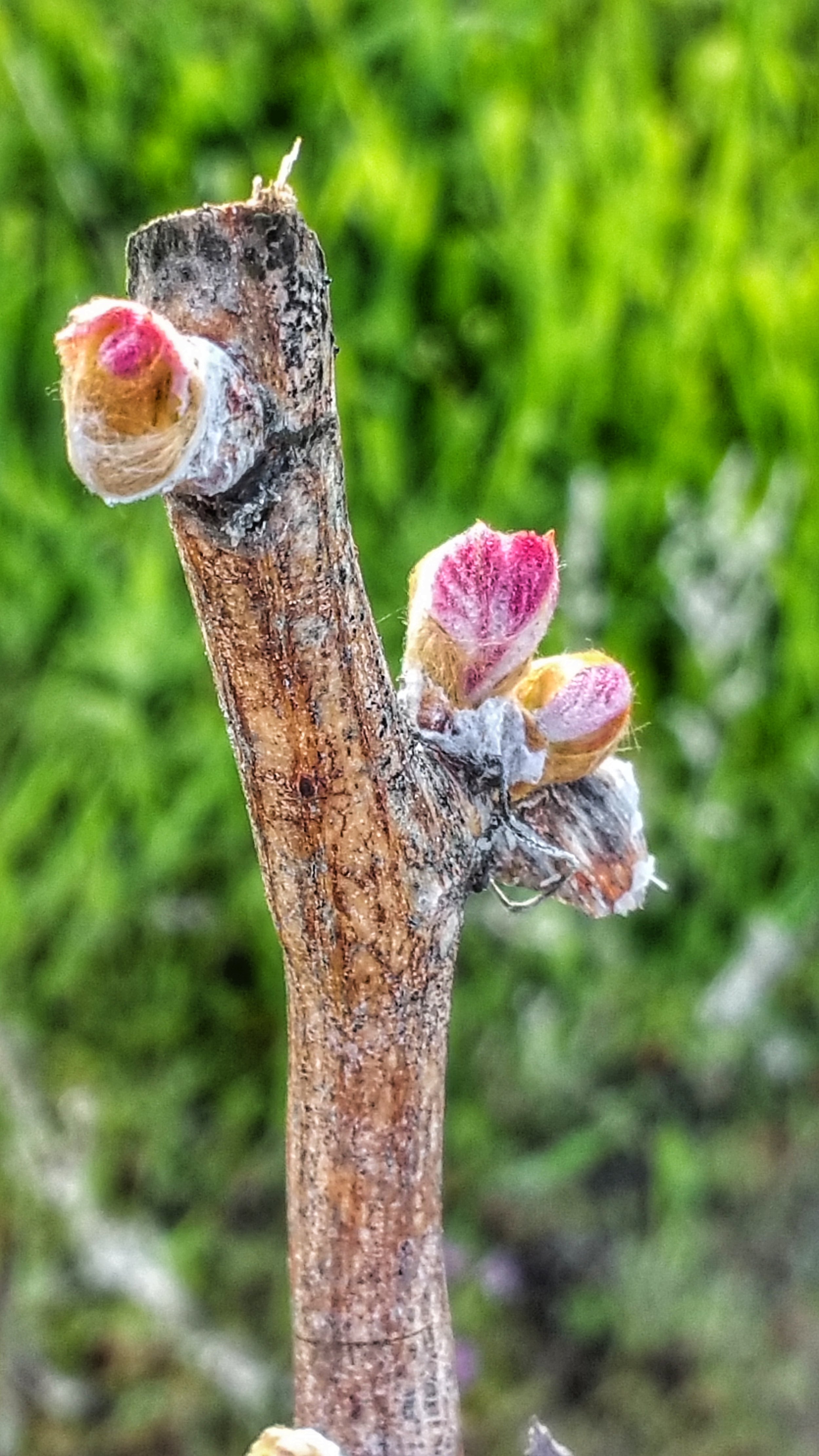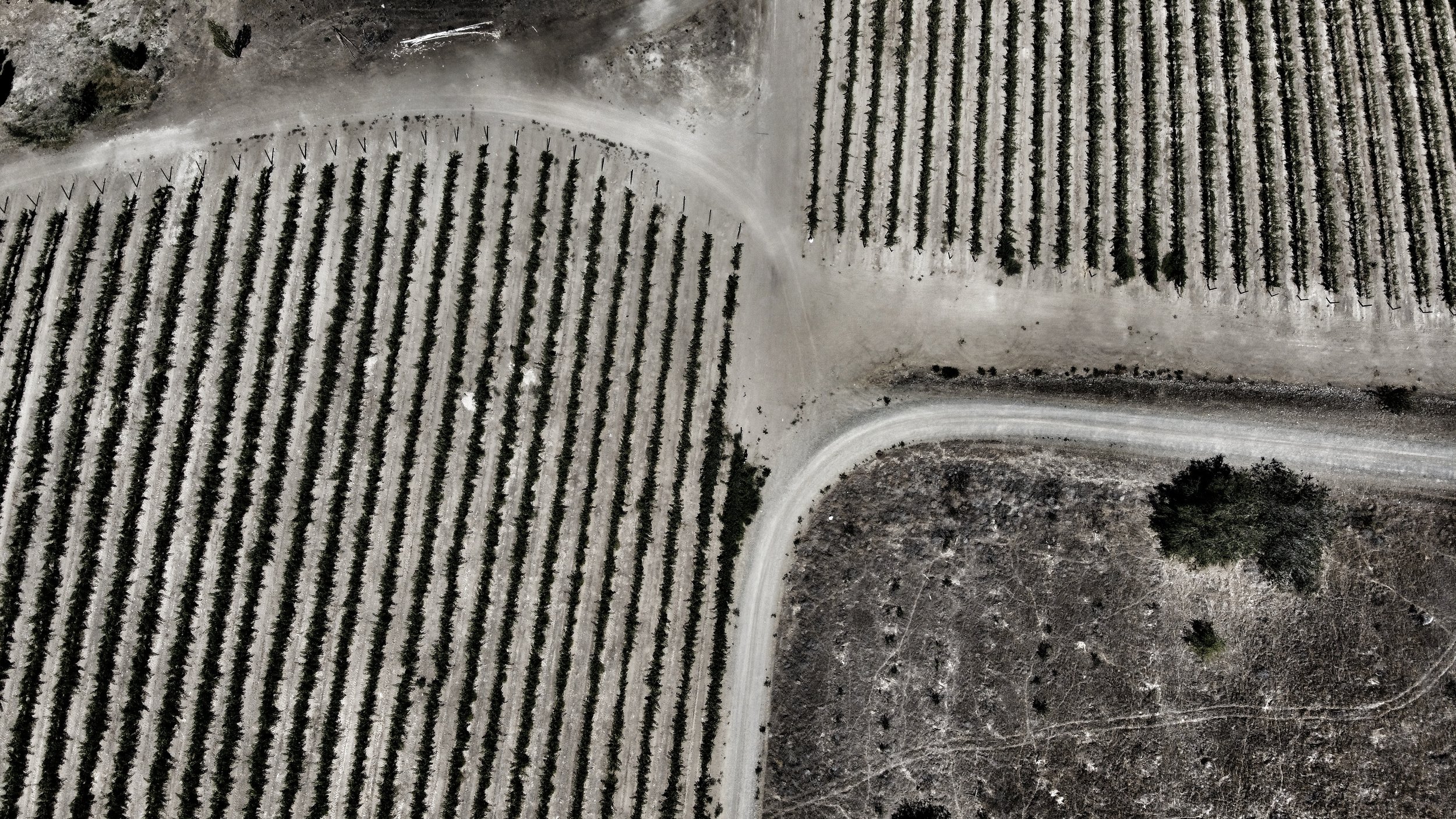

Putting in the Work
footsteps of a farmer
Jeremy Porter, Founder and Winegrower for RR Poet Wines, walking among the vines of PineBrake Vineyard.
In 2009, I planted the first Merlot vines at PineBrake Vineyard. My philosophy back then was that wine should represent the very best expression of a place, and that continues to be a philosophy that drives everything I do today. It is an ethos which succeeds only with great care and attention through all aspects of the winegrowing process, which of course starts in the vineyard.
The mantra ‘wine is made in the vineyard’ is a well-known and oft-touted one, but it is seldom practiced completely. Developing an estate vineyard is a monumental task. The levels of patience required to wait, year upon year, for the vines to reach their optimum potential to express the Terroir of a specific place are more than most are willing or able to endure.
To truly understand a vineyard, though (and the wines that are made from it), the site must be learned over time. The vineyard, in a sense, has to ‘tell’ you what it is. We have had to listen to the epic story of each varietal, clone, block, and even row at PineBrake in order to begin to understand the final wines that will be produced from it. This is a nearly impossible task if one is not intimately involved with the vineyard and willing to have the fortitude to truly understand ‘the place’.
Those first vines were planted, over a decade ago, with the explicit and deliberate purpose of one day creating the best expression of this site’s Terroir. Although it is a great test of patience, the endeavor to discover how a site uniquely expresses itself through its wines is one of the paramount joys of winegrowing, and in truth, it is one that continues to provide both challenge and joy to this day.
~Jeremy Porter, Owner & Winegrower
PineBrake Vineyard is comprised mostly of three Bordeaux varietals - Merlot, Cabernet Franc, and Cabernet Sauvignon. Although Cabernet Sauvignon is by far the most widely planted red varietal in the state, this particular area produces some of the highest quality Merlot and Cabernet Franc in the country.
At 1200’ elevation, well above the Yakima Valley floor, the vineyard sits atop one of the many characteristic rolling hilltops of the Rattlesnake HIlls AVA, which allows the fruit to mature to its optimum potential without pressure from early fall (or late spring) frosts. All the vines are own-rooted (ungrafted), which we believe captures the truest expression of our Terroir. The vineyard soils are predominantly characterized by a thin layer of wind-blown loess (silt-loam) soil, underlain by a deep layer of gravelly, cobblestone bedrock, known specifically as the Ellensburg Formation. This low-vigor, well-drained and rocky soil encourages the vine roots to dive deep, accessing the unique characteristics of this special ground.
The combination of elevation, soil type, and varied slope aspects - not to mention the incredible views from one of the highest spots in the Yakima Valley growing region - make PineBrake Vineyard a truly unique and special place.
“To truly understand wine, like people, one must understand where they came from.”
Jeremy porter | founder & operator

Sustainable Farming
a commitment to the future
This area of the world can spoil a winegrower. Low average rainfall, low humidity, and high heat index all contribute to limited mildew pressure in the vineyard. Unlike most winegrowing regions of the world, this allows us to be very judicious with our use of fungicides. In many years, we are able to use no mildew sprays at all. In some years we use only a limited amount of organic mildew control.
Additionally, pest pressures are much lower here than in many other regions. Deer and/or other grapevine-eating herbivores are not a problem. Harmful insects are few, and they are typically balanced by beneficial insects. As a result, insecticide use in the vineyard is nearly non-existent.
The low annual rainfall means that irrigation is a necessity. All of our vines are irrigated with a drip irrigation system, which allows us to focus the water precisely where the vines need it (the roots), allowing us to use only the water we need. The lack of rainfall and/or sprinkler irrigation also limits weed activity, allowing us to use zero herbicides in the vineyard.
Our focus at PineBrake is to create a balanced ecosystem in the vineyard. We use cover crops to enhance soil health and return nutrients back into the soil. We follow integrated pest management (IPM) practices to ensure that we are encouraging biodiversity in the vineyard. When needed, we only use control products listed on the LIVE green and yellow lists.
Our commitment to sustainable vineyard health not only makes it easy to feel good about our contributions to the future and our shared environment, but also it helps the vineyard to grow better fruit. End result: Better Wine!















The Terroir
The Rattlesnake Hills AVA - Est. 2006
The distinctiveness of the Rattlesnake Hills AVA is derived from its unique Terroir.
The location within the formidable Cascade Mountain rain shadow, as well as the overall south – southwest aspect of the Rattlesnake Hills’ aspect, combine to bathe the region in over 3000 average growing degree days’ worth of heat, making it an ideal location to consistently ripen premium-quality grapes.
The unique stone and gravel conglomerate bedrock, underlying a majority of the AVA, provide exceptional drainage, encouraging deep root penetration, contributing not only to the quality of the grapes grown in this region, but also the distinctive complexity in the finished wines.
Climate
Stand in nearly any vineyard of the Rattlesnake Hills AVA, and one is unable to ignore the two resplendent white mountain peaks rising up from the range of mountains to the west. These two mountains, Mount Rainier and Mount Adams, are the tallest in the Cascade Mountain Range, which splits Washington State roughly in half, north to south. Along with the even-further-west Olympic Mountains, these two formidable mountain ranges combine their dominance to shield the area from nearly all weather rolling in from the Pacific Ocean. This natural phenomenon is known as the “Rain Shadow Effect”.
Because of the Rattlesnake Hills’ location within this weather-protected zone, the growing season is nearly cloudless. In stark contrast to the rainforest-like conditions of the western Cascades and Olympics, the Rattlesnake Hills region is a Continental Semi-Arid Desert. There are roughly 300 days of sunshine in the Rattlesnake Hills, and the remaining 65 days that are less-than-sunny typically occur during the winter non-growing season.
Although it may seem obvious to say that great wine grapes need ample sun to aid in the production of sugars, color development, and overall physiological ripening, the type of sun is also important. The angle of the sun, length of day, and shift between nighttime and daytime temperatures (i.e. diurnal shift) all affect how grapes ripen and the overall quality of the fruit, as well as the desirability of the finished wine.
The Rattlesnake Hills Range (from which the Rattlesnake Hills AVA gets its name) snakes west to east along the north edge of the Yakima Valley, resulting in a generally south to southwest aspect for the overall Rattlesnake Hills AVA. This southerly aspect points the face of the hills into the sun, allowing the unobstructed sun’s rays to hit the surface of the ground at a more acute angle, increasing the overall heat that the ground receives. The average vineyard in the Rattlesnake Hills typically receives in excess of 3000 annual growing degree days.
But heat isn’t everything.
At ~46.5 degrees N, the area is among the highest latitude winegrowing regions in the world, but while similar northerly-latitude areas elsewhere in the world tend to be on the cusp of cool, rainy weather in the spring and fall, making viticulture difficult, this region is sheltered by the afore-mentioned rain shadow effect. With very little risk of destructive fall hail or rains, the grapes are allowed to ‘hang’ longer on the vine to develop optimal flavors. And, while the growing season is slightly shorter from beginning to end than more southerly wine regions, the number of “sun hours” received is equal to those of say, Napa Valley, due to incredibly long days at such high latitude – 16 hours of sun at the summer solstice.
Because of the Continental Semi-Arid Desert climate, as well as the high elevation of the AVA, Rattlesnake Hills vineyards experience very large swings between daytime and nighttime temperatures. This region exhibits some of the most dramatic diurnal shifts among all other wine regions of the world. There are regularly 40 degrees Fahrenheit difference between daytime high temperatures and nighttime low temperatures in the vineyards of the Rattlesnake Hills, and often even as much as 50 degrees of fluctuation. The importance of this wide diurnal shift cannot be overstated. The steep drop in nighttime temperatures allows the grapes to retain their much-desired natural acidity, a quality that is highly desired and sought-after for world-class wines. Although winemakers can adjust acidity in the winery, it is well documented that natural acidity integrates more seamlessly, resulting in a better tasting, more balanced wine.
stone
Although there is a beneficial diversity of soil types within the AVA, the majority are underlain with a mix of sandstones, siltstones, mudstones, and conglomerates (cemented gravel and cobble river stone in a sandy matrix), known specifically as the Ellensburg Formation.
The abundant cobblestones found in PineBrake Vineyard and many other vineyards of the Rattlesnake Hills AVA were derived from erosion of conglomerates, deposited within ancestral channels of the Yakima River, Columbia River, or their tributaries, which were draining to the east from the crest of the Cascade Range around 10 million years ago. In contrast to most other growing regions in the state, the Ellensburg Formation bedrock is much softer than basalt (the typical bedrock throughout much of the Columbia Basin, including much of the Yakima Valley), less resistant to weathering, and therefore responsible for the AVA’s characteristic rolling hills (as opposed to ledges, cliffs, or otherwise flat valley floor that are common in other parts of the Yakima and Columbia Valleys).
Ellensburg Formation represents the predominant bedrock in the Rattlesnake Hills AVA. Other than very small pockets elsewhere in the Yakima Valley, it exists nowhere else in the world. This gravelly, sandy, stone matrix is well-drained. It encourages the own-rooted vines of PineBrake Vineyard to dive deep, coaxing the distinctive nuances from this unique terroir, truly exhibiting a sense of this place in the finished wines.
visit the vineyard






